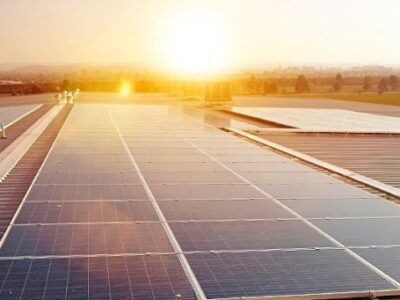America’s got a clean little secret — one of our largest, fastest-growing job sectors also happens to be essential to the future of our economy, to our resilience in weathering disasters natural and otherwise, and to the health of the planet. That’s why small businesses and Fortune 500 companies alike are putting their money on clean energy. From names you’d expect to hear: Tesla and General Electric, to others you might not: Google, Microsoft, Intel, Bank of America, Wells Fargo, Apple, Starbucks, Cisco, Goldman Sachs, HP — all of these made the Environmental Protection Agency’s list of Fortune 500 companies that use 100 percent clean energy, with each of them clocking more than 36 billion kilowatt-hours (kWh) of green power annually, equivalent to the electricity use of over 3 million average American homes. That adds up to big savings for all parties involved.
Small business owner John Seryak who heads up Go Sustainable Energy in Columbus, Ohio wants his fellow Americans to see energy efficiency as a virtuous form of cost-cutting. “A lot of organizations are going to focus on cost-cutting and energy efficiency helps to do that. It’s an economic activity that helps align with what customers want and need to do in the near term. It can have quick returns on investments, which is going to be highly valued. It creates jobs.” It certainly does.
Since 2015 clean energy jobs have grown 10.4 percent with 3.4 million clean energy jobs in the United States last year — 2.4 million in energy efficiency and 522,811 in renewable energy.
In a time of economic uncertainty as the pandemic stretches on, clean energy might save more than the environment, says Sonia Aggarwal, vice president at Energy Innovation. “What an incredible opportunity for economic stimulus. A federal clean energy standard, supported by government investments in deployment and American manufacturing, could put us back on track for a healthier economy.”
So what exactly is clean energy and where are these jobs? Hard-working Americans in every state and county make up the growing industry that includes efforts to generate electricity from the sun, wind and water, companies that build the systems and components to produce clean power, businesses manufacturing battery systems to store renewable energy, corporations focused on electric cars and recharging infrastructure, and those who make renewable fuel replacements like wood pellets, ethanol, renewable natural gas, and biodiesel. Energy efficiency makes up the largest sector, from construction workers, electricians, plumbers, heating, ventilation, and air conditioning technicians, to factory workers manufacturing ENERGY STAR appliances, windows, insulation, and LED lighting systems. Farmers who plant cover crops and use no-till practices are also part of the clean energy sector, enjoying incentives in both soil health and income. Solar and wind engineers and auto workers building electric and hybrid vehicles are increasingly in demand. Just a year after General Motors shuttered their massive plant in Lordstown, Ohio, a “battery-powered economic revival” came to town in the form of Lordstown Motors, which bought the factory to build the electric pickup truck they call “Endurance.”
In April 2019, renewable energy outpaced coal energy for the first time ever, providing 23 percent of US power generation to coal’s 20 percent share. That same year, wind and solar energy claimed 50 percent of US renewable electricity generation, threatening hydropower’s dominance. Unlike fossil fuels, investing in renewable energy is a front-loaded venture, with hefty initial costs of purchasing land and installing wind turbines or solar panels. However, the long-term maintenance is significantly less and the investment pays off quickly. With declining renewable energy costs and innovations in energy storage, analysts predict the trend toward clean energy will overtake coal, gas and nuclear power entirely. It’s already happening in some states, with regulators hesitating to invest in non-renewable capacity upgrades. Last year, Indiana regulators refused Vectren’s proposal to replace a baseload coal plant with a new natural gas-fired power plant, pushing the utility to come up with renewable alternatives.
A recent national study using the latest low renewable energy and storage prices reported that with policy support, the US can deliver 90 percent clean, carbon-free electricity nationwide by 2035, at no extra cost for consumers. In fact, this plan would increase energy sector jobs by over half a million each year, injecting $1.7 trillion of investment into the economy. Delivering 90 percent clean electricity by 2035 would avoid $1.2 trillion in environmental health costs by reducing damages from carbon emissions and air pollution. The report estimates up to 85,000 unnecessary premature deaths in the US associated with air pollution from power plants could be avoided through 2050. This is the first study of its kind to reflect recent cost reductions for solar, wind and battery storage, demonstrating how renewable energy can reduce generation and emissions from existing fossil fuel plants, ultimately retiring coal and dramatically reducing gas generation by 70 percent. There is sufficient time between now and 2035 for coal and gas plants to recover fixed costs, avoiding risk to investors and consumers, assuming supporting policies are in place.
“We’re talking about the ability to achieve near-100 percent clean electricity by 2035, in half the time most people are talking about,” says David Wooley, professor at the UC Berkeley Goldman School of Public Policy and executive director of the Center for Environmental Public Policy. “This is exciting because the 2035 timeframe is actually compatible with climate realities. However, this outcome isn’t possible without strong policy changes and our hope is this report can help inform the dialogue on federal, state and corporate policies needed to achieve it.” As multiple stakeholders move toward collaboration and increased innovation, clean energy is America’s ticket to strengthening the economy and preserving our natural resources for generations to come.





